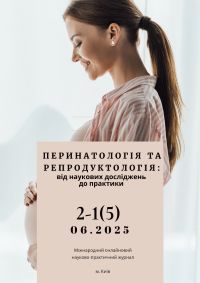Comparative clinicalandlaboratory description of patients with the functional ovarian cysts depending on medical tactic
Keywords:
functional ovarian cysts, methods of treatment, clinic, laboratory methods, comparative aspectsAbstract
DOI: 10.52705/2788-6190-2025-02.1-17
УДК 618.11-006.2-00788-08-035-076/.078
The objective: to study comparative clinical-and-laboratory descriptions of patients with the functional ovarian cysts depending on medical tactic.
Materials and methods. All 104 patients parted on 4 groups: a 1 group is a basic group (n = 22) patients with the uncomplicated flow of ovarian cysts (follicle cysts and cysts of yellow body), recipient base therapy: antibacterial preparations, nonsteroidal anti inflammatory drugs, antispasmodics, resorption therapy; 2 a group is a group of comparison I (n = 27) patients with uncomplicated / by the complicated flow of ovarian cysts, operated in a volume organ-preserving operations (cystectomy), recipient base postoperative therapy, proper to the industry standards; 2 a group is a group of comparison II (n = 30) patients with ovarian retention formations, operated in a volume organ-preserving operations (cystectomy), recipient standard base postoperative therapy and monophase combined oral contraceptives in the cyclic mode; 3 a group is a control group (n = 25) – de bene esse healthy women in age 18–39 years, not having in anamnesis of operative interferences on ovaries. In a basic group and groups of comparison I and II the comparative analysis of clinical-andlaboratory descriptions of patients is conducted with functional cysts depending on the variant of therapeutic tactic. Clinical, laboratory, instrumental, morphological and statistical methods were plugged in the complex of the conducted researches.
Results. Operative interference was executed at most patients during the first two days from the moment of hospitalization and only to 6 (10%) women an operation was executed on 4–5 days after a receipt. Duration of operative interference for certain did not differ for the patients of both groups, averaging 36 ± 7 minutes. In a postoperative period all patients got antibacterial therapy during 3–5 days, spasmolytic therapy, narcotic analgetics during the first days. Postoperative complications it is not diagnosed for any patient. A pain symptom stopped during 2,3 ± 0,4 days. Stitches removed the on 6–7 days, healing a primary tensions. On 2–3 days after a cystectomy at 49 (86%) a menstrual-similar reaction came duration 4–5 days. During the first three days of menstrual-similar reaction of patient of group of comparison II began to accept low-dose the monophase combined oral contraceptives on a contraceptive chart. On 6–7 days of postoperative period the normal sizes of uterine appendages are diagnosed for 89,5% patients, in 10,5% uterine appendages appeared large, but without by volume educations, that was confirmed by ultrasonic research. An insignificant sickliness or sensitiveness at palpation was marked by 12,3% women, it is not exposed in other cases of sickliness.
Conclusions. Existent methods are effective not enough in treatment and prophylaxis of relapse of functional ovarian cysts. Independently of the chosen medical tactic frequency of offensive of pregnancy does not exceed 38%, the relapse of cystophorous education is diagnosed for every seventh-eighth patient. For every second operated patient (54%) in remote terms on the result of the extended EFORT-test reductions ovarian reserve is diagnosed. Findings testify to the necessity of search of new, pathogenetically justified methods of treatment of functional cysts of ovaries.
Downloads
Published
How to Cite
Issue
Section
License

This work is licensed under a Creative Commons Attribution-ShareAlike 4.0 International License.


